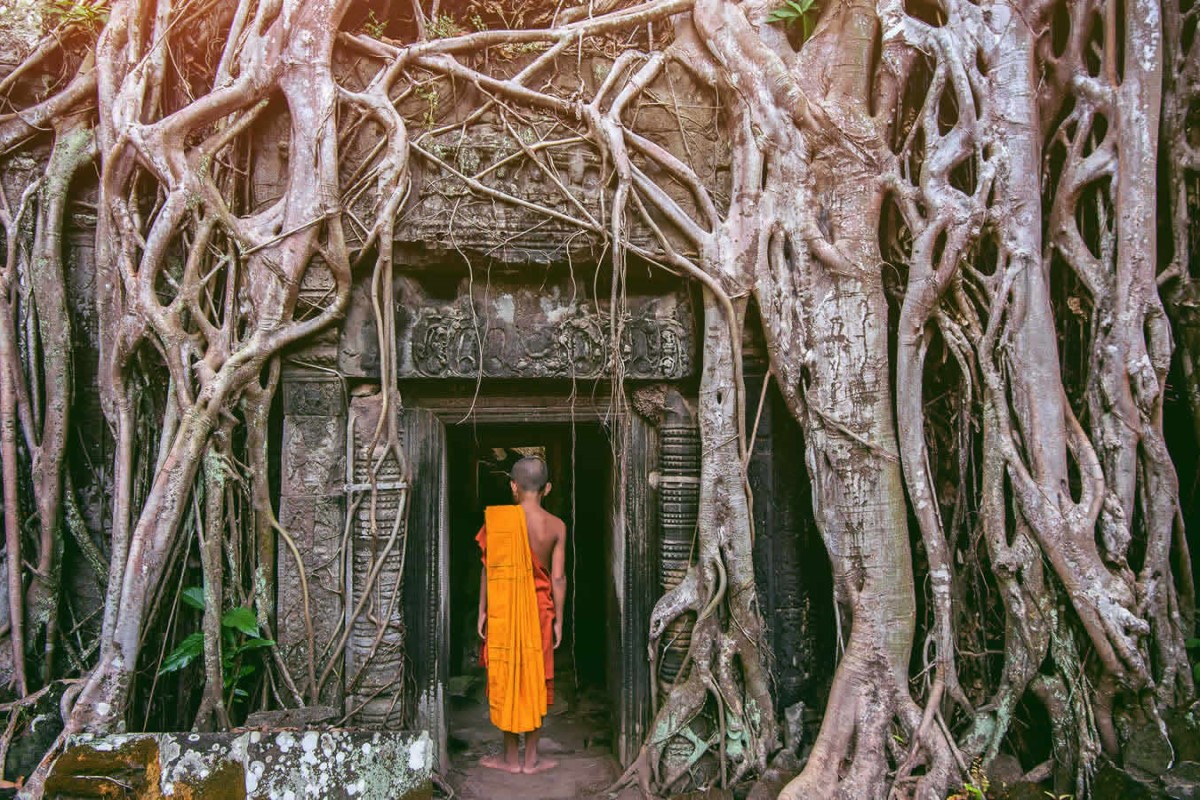


Temples. Culture. Traditions. These are just a few things that Siem Reap, the second largest city in Cambodia and the country’s cultural capital, has to offer. While Siem Reap is most famous for being the jumping off point to Angkor Wat, a temple some argue should be one of the Seven Wonders of the World, it is also famous for its interesting mix of French and Chinese architecture, thriving food scene, and bustling markets full of local artisans.
Explore Angkor Wat
Section Type: standardWidthImageS
Tuk-tuk entering an archway at Angkor Wat

Angkor Wat is living history personified. Not only is it one of the best-preserved temples in the world, but it is also the only historical temple that has remained a significant religious center since its construction.
Built in the 12th century, Angkor Wat is full of history, from its Hindu origins to its occupation by the Khmer Rouge. Spread over 400 acres, it could take you several days to fully explore all the detailed bas reliefs, statues, and well-preserved ruins, as well as broken walls, caved-in ceilings, huge tree roots and jungle vistas.
In 1860, French explorer Henri Mouhot once said:
Section Type: quoteWBackgroundAndTopBottomDividerLine
“One of these temples - a rival to that of Solomon, and erected by some ancient Michael Angelo - might take an honourable place beside our most beautiful buildings. It is grander than anything left to us by Greece or Rome, and presents a sad contrast to the state of barbarism in which the nation is now plunged.”
Nowadays, don’t be surprised to see large groups of Buddhist monks and nuns milling about or meditating in a quiet spot. Likewise, you’ll also see ceremonies and statues covered in saffron sashes with offerings of incense, fruit, flowers and water.
Just as it is every traveler’s dream to go to Angkor Wat, it is also the pride of every Cambodian.
Eat the most delicious foods
There’s no better way to learn about a local culture than to sample its food. Dishes in Cambodia vary from noodle soups, spring rolls, curries, and dumplings to sticky rice. For beverages, you have a choice of green tea, smoothies or coffee served with sweetened condensed milk.
Amok is probably Cambodia’s most famous dish, a curry made of fresh coconut milk and kroeung, a spice marinade of lemongrass, magrut lime zest and leaves, galangal, turmeric, garlic, shallots and dried red chillies, served with rice, of course, and your choice of seafood, chicken or vegetables.
For dessert, you should eat sticky rice, which is often served with durian, a fruit that is infamous for its awful stench, but actually tastes super sweet.
Traditionally, Cambodian food was eaten with the hands, but nowadays, it’s more common to use spoons and forks for rice dishes, and chopsticks for noodle dishes.
Shop ‘til you drop at local artisan markets
Section Type: standardWidthImageS
Local resident selling fruits and flowers at a market

Whether you like to shop or not, it’s a must-do activity in Siem Reap and artisan markets are the perfect place to get a taste of local culture. For the best prices, go at dawn, and don’t forget to haggle!
There are dozens of markets to choose from in Siem Reap. The biggest ones are the Old Market and the Night Market, where you’ll find anything and everything, from vegetables, meat, motorbike parts, clothing, souvenirs and knock-off books and DVDs. At the Night Market, you can also enjoy street food and live music.
If you’re looking for something a little different, though, you should check out “Made In Cambodia,” which is a small market just two streets long, that sells unique, one-of-a-kind crafts from local artisans who are open to lingering and chatting about life and art.
Get to know the Cambodian people
Section Type: standardWidthImageS
Tonle Sap local life scene

Getting to know local residents and learning about their traditions is what authentic and meaningful travel is all about. While in Cambodia, you’ll need to get around by tuk-tuk, a three-wheeled vehicle with a motorbike in front and several seats in the back, which will take you on a slightly hair-raising adventure through the busy streets. In fact, to get to Angkor Wat, tuk-tuks are the preferred transport of choice.
When greeting people, the sampeah is used in lieu of shaking hands or waving. This involves pressing the palms of the hands together in front of the chest, accompanied by a small bow. If a person is important, such as a monk, then the hands are placed higher on the body, for example at the nose, with a deeper bow.
You’ll notice many locals and foreigners alike wearing a colorful checkered scarf called a krama, which is also used as a bandana, a hammock for infants, a towel or a sarong, just to name a few. During the Khmer Rouge, it was the standard form of garment that everyone was obligated to wear.
If you want to learn even more about traditional ways of Cambodian life, you should also tak the opportunity to visit Tonle Sap, Southeast Asia’s largest lake which is home to approximately 2 million people. There, you can take an exclusive boat ride with SA Explorations to the floating villages, where people live in homes constructed on top of bamboo rafts latched together. Tonle Sap is one of Cambodia’s most important landmarks and a UNESCO nature reserve full of incredible biodiversity.
About the author: Julia Guerra Slater has traveled extensively throughout the world, including a 6-month backpacking trip in Southeast Asia. She has spent an extensive time living as a digital nomad.
Section Type: cta
Feeling inspired to include Cambodia in your next expedition? Check out our 14-Day Vietnam to Cambodia highlights, or another favorite, the 13-Day Best of Thailand and Cambodia. Want to go beyond Cambodia? Explore all our Southeast Asia itineraries.


Copyright © 2025 SA Luxury Expeditions LLC, All rights reserved | 95 Third Street, 2nd floor, San Francisco, CA, 94103 | 415-549-8049
California Registered Seller of Travel - CST 2115890-50. Registration as a seller of travel does not constitute approval by the state of California.










